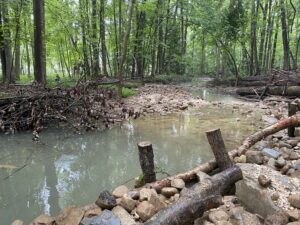Spring Brook Stream Restoration
Geauga Park District, in partnership with Chagrin River Watershed Partners, was awarded a $219,000 Ohio EPA Section 319(h) grant in 2020 to restore 800 linear feet of Spring Brook, a coldwater habitat stream, that would improve water quality and habitat for Bass Lake and the Chagrin River Watershed.
Spring Brook is a tributary of Bass Lake, which drains to the Upper Main Branch of the Chagrin River. Bass Lake is a part of Bass Lake Preserve, a 606-acre park home to many native plant and animal species. Spring Brook meanders through Spring Brook Sanctuary, which is a designated State Nature Preserve.
Spring Brook was once a healthy stream made up of a combination of substrate with well-developed riffles, runs, and pools. This was a great habitat for sensitive cold-water species, such as the state endangered Ohio brook trout. Over time, however, the stream had degraded, and the substrate was scoured down to mostly hardpan clay, leaving unsuitable habitat for sensitive species. In addition, the streambanks were heavily eroded, leading to increased sediment.
EnviroScience, River Reach Construction, and GPD Group were contracted as the design-build team to complete the restoration using natural channel design principles and bioengineering methods. Riffle pool complexes were reconstructed to create stability to the stream channel and provide habitat once again for sensitive cold-water species. Spring Brook was also reconnected to its floodplain. Floodplains are vital for stream stability as they reduce the volume and energy in the channel by providing overbank storage of flow and will also prevent future erosion on the streambanks. The project also made use of boulders, woody debris, branch, and log revetments to add stability to the streambanks and create additional habitat within the stream channel. The project also enhanced about 2 acres of riparian area with invasive species removal and native species plantings.
- Continue to fact sheet
Funders and Partners:
This project was financed in part or totally through a grant from the United States Environmental Protection Agency through an assistance agreement with the Ohio Environmental Protection Agency. The contents and views, including any opinions, findings, conclusions or recommendations, contained in this product or publication are those of the authors and have not been subject to any Ohio Environmental Protection Agency or United States Environmental Protection Agency peer or administrative review and may not necessarily reflect the views of the Ohio Environmental Protection Agency or the United States Environmental Protection Agency and no official endorsement should be inferred.
- Continue to project story map







